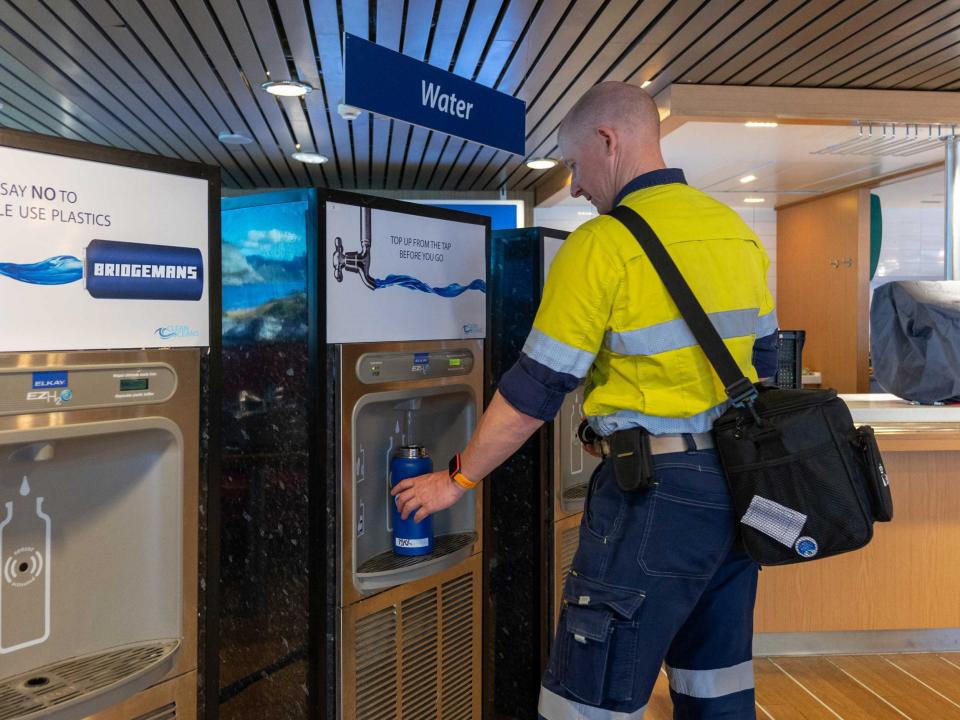A company is turning former cruise ships into floating hotels — see inside its largest 'floatel'
Bridgemans ServicesGroup operates a fleet of former cruise ships turned into hotels.
Its "floatels" are designed to house workers during long-term projects.
See its largest 652-cabin floatel with a game room and buffet.
Some old and unwanted cruise ships meet their demise at ship-breaking yards, where they are disassembled and sold for scrap.
Other vessels find a more fortunate fate, receiving a second chance to do what they already do best: serve as floating hotels.
Canada-based Bridgemans Services Group buys and charters former cruise ships to turn into "floatels," outfitted with standard cruise amenities like daily housekeeping, buffets, and relaxing lounges.
But the ships aren't designed to transport tourists from one destination to another anymore. Instead, companies turn to Bridgeman when they need to house workers for a long-term project, whether it be the construction of an offshore wind farm in Europe or the shooting of a major film in a remote destination.
Floatels can accommodate workers in remote destinations where hotels might not be an option.

In more metropolitan areas, Bridgemans says its ships could lessen the stress an inundation of workers might have on the local housing market.
And once they are no longer needed, the vessels depart and "leave no trace behind," the company said.
Over the last decade, Bridgemans has deployed its ships for 15 projects on every continent, Brian Grange, the company's president, told Business Insider.

Grange said that its deployments — most often for liquified natural gas companies — last for an average of two years.
In the past, it has also provided accommodations for MSC Cruises at its Ocean Cay private island and housing for more than 1,000 workers in the Philippines' on a project for the Manila International Airport during the COVID-19 pandemic.
The company's three ships range from 150 to 652 cabins.

The floatel operator acquired its largest ship, the 561-foot-long MV Isabelle X, in 2023.
In its past life, the 35-year-old vessel sailed around the Baltic Sea as one of Estonia-based Tallink Gruipp's cruise ships.
But gone are its days of leisurely cruising. The 35,000 gross-ton ship is now on its first deployment in Howe Sound, just north of Vancouver, where it's housing more than 600 workers who are building Woodfibre LNG's "net zero" LNG export facility.
Isabelle X underwent a six-month retrofit before it was sent to Howe Sound.

The process included updating the ship's cabins and adding amenities like a game room and an 8,000-square-foot gym.
The latter two are especially important: "We need to make sure we delineate between work and home," Grange told BI. "We have to create a social environment on board these vessels that makes it attractive for workforces around the world."
During their free time, workers can play billiards, relax in the outdoor lounge, or use the ship’s WiFi to catch up on social media.

The sports lounge has large television screens, while the games lounge has darts, ping pong tables, and air hockey.
The 'quiet lounges' are the go-to space for people who need to unwind after a long work day.

Or, they could recharge and catch up on the latest shows in their cabins, which all come with desks, storage, and 32-inch televisions.
Like a typical cruise ship, Bridgemans' vessels have buffets with live cooking stations, a dessert bar, and the occasional themed night.

The ships' chefs tailor their menus to the demographic and dietary restrictions of the workers on board, the company's president told BI.
Residents can expect at least four protein options, plenty of veggies, and handmade bread and desserts.
Unlike most cruise lines, Bridgemans can pre-purchase all the food it needs before deployment.

Grange says this allows the ships to maintain food quality and consistency in remote locations.
Remember that deployment in the Philippines during COVID-19? He said the ship had packed almost 800 tons of food ahead of the project.
He wouldn’t disclose the cost to rent one of Bridgemans’ floatels.

But he did note that the cost of a cabin on the Woodfibre LNG project in Howe Sound is comparable to a hotel room in nearby Vancouver, as is the case with most of its projects near major cities.
The company’s most recent acquisition, the 150-cabin Diamond XI, is currently being retrofitted and would be ready for deployment this year.

According to the company's president, the vessel is small and high-end, likely to be used for sporting events and movie shoots.
It could also be the start of a greater expansion: He hopes to add two or three more vessels to its fleet in the next five years.
"The world has opened up to this as a valued alternative to housing," Grange told BI.

Who knows, the next time you see a cruise ship off the coast, there's a slim but possible chance it could be housing workers — not vacationers.
Read the original article on Business Insider


